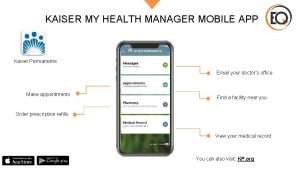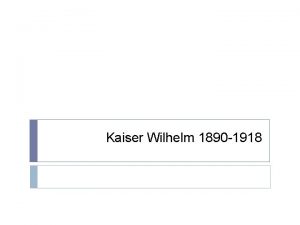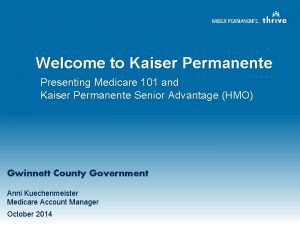Kaiser Permanente A Model of Integration and Market












- Slides: 12

Kaiser Permanente: A Model of Integration and Market Leader in Quality and Service Differentiation Healthcare Information Technology January 14, 2003 Robert Pearl, MD Executive Director and CEO The Permanente Medical Group

KP’s Unique Partnership n The Kaiser Permanente Medical Care Program is a partnership between 3 entities u Kaiser Foundation Health Plans Nonprofit regional health plans that contract with members (individuals and groups) for prepaid comprehensive health care services u Kaiser Foundation Hospitals Nonprofit corporations that own and operate or contract for hospital facilities and services u The Permanente Medical Groups Regional Medical Groups, represented nationally by the Permanente Federation, which contract exclusively with KFHP/H to provide medical services 2

Northern California n n n Over 3. 2 million members More than 4, 000 physician FTE’s More than 55, 000 employees 17 hospitals 32 medical offices 12 home health/hospice agencies 3

VOLUME OF CARE DELIVERY 2000 n 16. 70 million office visits n 245, 000 hospital admissions n 27, 478 births n More than 21. 60 million prescriptions 4

5

CCHRI Reports on Quality 2000 -2002 Northern California Medical Plans Measures reported varied by year but included the following major categories: • Asthma • Comprehensive Diabetes Care • Cholesterol Management After Acute Cardiovascular Event • Mental Health • Young Families • Women's Health

7

University of California Ratings of Care for California Medical Plans: 2002 Survey of Member Satisfaction Note: Survey results are based on responses from more than 4800 members of the University of California Health Plans in California and New Mexico.

DMHC Summary of Enrollee Complaints for Six Largest California Health Plans, Calendar Year 2001 9

High Ratings Result in Favorable Recognition • “Excellent” accreditation from the National Committee for Quality Assurance (NCQA) – One of only two California health plans to receive “excellent” status for both commercial and Medicare plans • 2001 Blue Ribbon Health Plan and Medical Group Awards from the Pacific Business Group on Health • Ranked first among Northern California HMOs by Consumer Reports in 2001 review

30 -Day Mortality After Acute Heart Attack KP NCal hospitals vs. all other hospitals in counties with KP hospitals 25 = statistically sig. p<0. 01 20 KP THE REST 15 13% 10 8% 5 0 Source: OSHPD

Different from the Rest of Health Care Our accomplishments are a direct result of the unique qualities of Kaiser Permanente. Here at least 3 reasons that have contributed to us being the Leader in Health Care today. Integration Not-for-Profit • Partnership between Health Plan, Hospitals and Medical Group • We spend more than 95% of the health care dollar on direct patient care vs. the for-profit competition which spends less than 85%. • Coordination between Inpatient Care and Outpatient Care • Collaboration between Primary Care, Specialty Care and Diagnostic Care • Linkage of preventive care, urgent care and chronic care • Connection of Information Technology with the our Delivery System • Unlike for-profit companies which must focus on quarterly financial returns to maximize their share price, we take a longer-term view about the health of our members. For this reason, we invest more in our people, facilities and disease prevention. • Because 98% of our members re-enroll with us each year, we make significant investments in their health for decades to come. Our chronic conditions management programs are good examples of our long-term investment and commitment to our members. Physician Autonomy • Unlike the rest of medicine where physicians must obtain authorization to provide proper medical care, our physicians practice medicine without interference from insurance administrators and clerks. • Because clinical decision-making rests in the hands of our physicians and their patients, our physicians can prescribe medications, consult with colleagues, perform surgery or decide to hospitalize based solely on their discussion with the patient. 12
 Kaiser permanente mission vision statement
Kaiser permanente mission vision statement Kaiser santa rosa
Kaiser santa rosa Kaiser hospital santa cruz
Kaiser hospital santa cruz Kaiser springfield pharmacy
Kaiser springfield pharmacy Kaiser bridge program
Kaiser bridge program Www.kp.org/mfa/scal
Www.kp.org/mfa/scal Kaiser permanente service area map
Kaiser permanente service area map Labor management partnership environment
Labor management partnership environment Kaiser mobile app
Kaiser mobile app Pamela schwartz
Pamela schwartz Kaiser permanente san diego family medicine residency
Kaiser permanente san diego family medicine residency Kaiser permanente spokane walk in clinic
Kaiser permanente spokane walk in clinic International segmentation
International segmentation

















